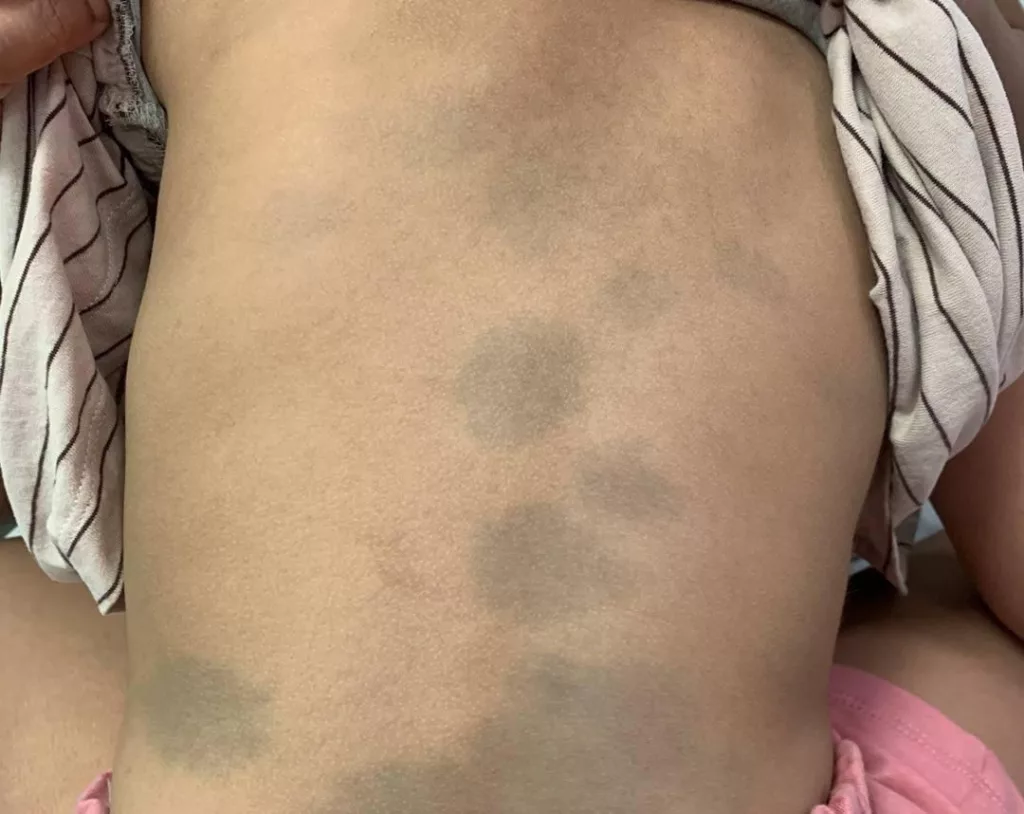Okay, mama (or papa!), let’s talk. You’re gazing at your gorgeous newborn, maybe during a nappy change or a post-bath snuggle, and you notice it: a flat, bluish-gray mark, often on their little bum or lower back. Your heart probably did a little flip, right? Thoughts might race: “Is that a bruise? Did I bump them somehow? What is that?”
First off, take a really deep breath. Seeing something unexpected on your baby’s perfect skin can be worrying, I completely get it. I’ve sat with so many parents, just like Kate who was worried about her baby Emma, who felt that same knot of concern. But chances are, what you’re seeing is something called a Mongolian blue spot. It sounds a bit exotic, maybe even worrying, but trust me on this one – it’s almost always completely normal and totally harmless.
Think of it as one of nature’s little variations. Let’s chat about what it really is, so you can swap that worry for wonder.
So, What IS This Little Blue Mark, Anyway?
It might look mysterious, but the reason behind these spots is actually pretty straightforward science, happening before your baby even made their grand entrance!
Tiny Color Cells Taking a Detour
Imagine tiny little cells, called melanocytes, on a big journey while your baby is growing inside you. Their job is to make melanin, the pigment that gives skin its color, and their final destination is the top layer of skin (the epidermis). But sometimes, a few of these little travellers get a bit sidetracked and end up settling deeper down, in the lower layer of skin (the dermis). They just kind of… got stuck there.
Doctors have a fancy name for this – congenital dermal melanocytosis – but it really just means pigment cells present in the deeper skin from birth.
The Magic Trick: Why Blue and Not Brown?
“But if they’re pigment cells, why blue?” Great question! It’s less about the actual color of the pigment and more about location, location, location, plus a bit of light physics.
Think of it like looking at deep water – the water itself isn’t blue, but that’s how it appears because of how light scatters through its depth. Similarly, when those melanocytes are deeper in the skin, the way light hits them and bounces back to your eye makes the area look bluish, gray, or sometimes even a bit greenish. It’s an optical effect, not a sign of anything wrong!
Is It Really Not a Bruise? How to Tell for Sure
This is the big one, isn’t it? That immediate “Oh no, is it a bruise?” thought. It’s a very common confusion, but thankfully, there are clear ways to tell the difference:
Clues It’s a Mongolian Spot (Not a Bruise):
- Color Consistency: Mongolian spots stay that blue-gray shade. They don’t do the bruise rainbow (going from purple/red to green to yellow over days). What you see today is likely what you’ll see tomorrow.
- Shape: While they can be oddly shaped, the edges are usually pretty clear. Bruises tend to be more splotchy and fade out at the borders.
- Feel & Tenderness: This is key! Gently touch the area. The skin over a Mongolian spot feels exactly like the skin around it – smooth, same temperature. Most importantly, it doesn’t hurt your baby when you touch it. A bruise is usually tender or sore.
- Origin Story: These spots are there from birth or appear very shortly after. They don’t show up suddenly after a tumble (unless, by coincidence, a bruise happens nearby!). They also fade very slowly over years, not days.
So, if the spot isn’t tender and its color is stable, you can feel much more confident it’s just one of these harmless birthmarks.
That Name Though… “Mongolian” Blue Spot?

It does sound specific, doesn’t it? The name actually comes from a German scientist back in the 1800s who studied them extensively in Mongolian people, where they are very common. The name kind of stuck, even though we now know these spots pop up in babies all over the world!
A Touch of Culture and History
Isn’t it fascinating how something medical can also be wrapped up in culture? In many parts of the world, these little blue marks are seen as special:
- Some Japanese traditions view the ‘blue bottom’ as a blessing or a mark left by a deity.
- In Korea, they’re sometimes seen as signs of good luck.
- Some Latin American folklore connects them to ancestral spirits.
It adds a layer of richness, doesn’t it? It’s not just a birthmark; for many, it’s a little link to heritage or folklore.
How Many Babies Actually Get These? (Spoiler: A LOT!)
You might feel like your baby is the only one, but these spots are incredibly common, especially depending on ethnic background. It really highlights the beautiful diversity of human skin! Roughly speaking:
- Babies with Asian, African, Native American, or Hispanic heritage: A very high percentage, often 80% or more, will have them. It’s almost expected!
- Babies with Caucasian heritage: It’s much less common, maybe only 10-20%.
So, chances are, your baby is part of a very large, very normal club!
Will It Be There Forever? (Probably Not!)
Okay, so it’s normal, but will it fade? For the vast, vast majority of babies, yes, absolutely.
- The Vanishing Act: Most Mongolian blue spots slowly lighten and disappear completely by the time your little one is a toddler or preschooler, usually between ages 3 and 5.
- The Lingering Few: Very rarely, especially if a spot is unusually large or dark, a faint hint might remain into childhood or adulthood. But honestly, that’s quite uncommon for the typical spots on the back or bottom.
Think of it like a little welcome stamp that gently fades as they embark on their big adventures in life.
Okay, But Is There Ever a Tiny Reason to Worry?
It’s natural for a parent’s mind to go to the “what ifs.” While these spots are overwhelmingly benign, in extremely rare situations, certain types of blue spots might warrant a doctor taking a second look, mostly to rule out other possibilities. These situations are the exception, not the rule, but include:
- Spots in unusual places (like the face, chest, arms, or legs).
- Multiple spots scattered over the body.
- Very large spots covering a significant area.
- Spots that don’t seem to fade at all over many years.
- Spots occurring alongside other significant skin changes or birthmarks.
Again, this is very rare. If your baby has a typical spot on their lower back or bum, it’s almost certainly just that – a normal Mongolian blue spot. But always feel comfortable pointing it out to your pediatrician at checkups. They can confirm it for you and offer that final layer of reassurance.
Why Your Doctor Should Note It Down (The “Just in Case” Reason)
Here’s a practical tip: Because these marks can look like bruises to the untrained eye, it’s a really good idea to make sure your baby’s doctor or midwife notes the presence of the Mongolian blue spot in their official medical record right from the start.
Why? It simply avoids any potential confusion later on, perhaps at daycare or if another doctor sees your child. Having it documented clarifies that it’s a birthmark, present from the beginning, and not an injury. It’s a simple step for peace of mind.
So, About That Bluish Mark… The Simple Truth
Let’s wrap this up with the key takeaways, the things to hold onto when you look at that little mark:
- It’s a harmless birthmark, just some pigment cells chilling a bit deeper in the skin.
- It looks bluish-gray, usually on the lower back/bum, and feels flat and smooth.
- It’s super common, especially in babies with gorgeous darker skin tones.
- It’s NOT a bruise – it doesn’t hurt and doesn’t change color day-to-day.
- It will almost certainly fade away on its own by preschool age.
- No treatment is needed.
- Getting it noted in your baby’s medical record is a smart move.
That little blue patch that might have initially caused a flutter of worry is, in reality, just a tiny, temporary part of your baby’s unique story. It doesn’t hurt them, it doesn’t mean anything is wrong, and soon enough, it will likely be a distant memory. So, breathe easy, enjoy those baby snuggles, and know that this little mark is just another perfectly normal part of your amazing little human.


